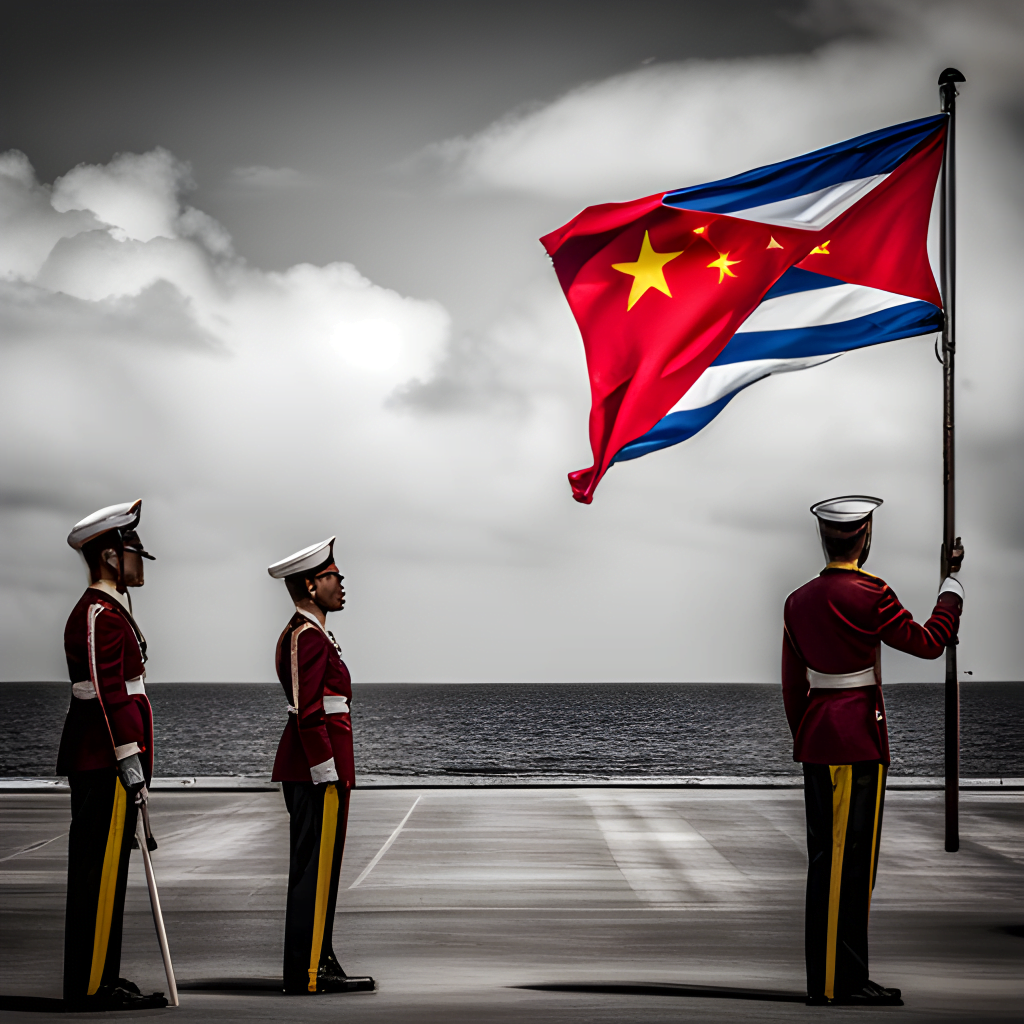China’s recent move to establish a military training base in Cuba has set the stage for a new chapter in the saga of global geopolitics. This decision amplifies China’s military expansion, placing it squarely in the Western Hemisphere, and has drawn the attention of global powers, notably the United States.
The forthcoming base, which is projected to be operational in a few years, is regarded as a strategic maneuver by China to augment its military influence. This development has gained coverage by numerous reputable sources such as The Telegraph, Bloomberg, and National Review.

The Geopolitical Significance of the Base
In the heart of Cuba, a new pillar of China’s military might have been erected – a military training facility. This base sits just 90 miles (ca. 145 km) from the United States, reflecting China’s strategic positioning to maintain a close watch on America. This geographical closeness offers China an unprecedented advantage to monitor U.S. military activities.
With the U.S. mainland in its vicinity, China can keep a constant eye on the operational strategies of the U.S. military. This proximity could afford China a crucial tactical edge in a potential conflict, enabling rapid responses to any regional developments. This new base, for instance, could expedite troop deployment, or act as a launch pad for a swift retaliation in case of military escalation.
Beyond its military benefits, Bloomberg suggests that the base could also serve as a hub for China to broaden its espionage activities. From this vantage point, China could garner valuable information on U.S. defense strategies, technology advancements, and other sensitive details. As China continues to strive for global superpower status, such intelligence could significantly shift the balance of power.
Furthermore, the strategic placement of this facility in Cuba not only impacts the U.S. but also shapes the geopolitical landscape of the entire region. Cuba, which has historically been an ally of China, could find its geopolitical role strengthened, as it now hosts a major global power’s significant military presence.
China’s Military Upgrade
The revelation of the training facility in Cuba marks a significant milestone in China’s long-term military modernization plans. Over the past several decades, China has been steadily upgrading its military capabilities to compete on the global stage. This modernization drive seeks to establish a military force that is not only larger but also more efficient, technologically superior, and capable of projecting power far beyond its own borders.
China’s People’s Liberation Army (PLA), the driving force behind this modernization initiative, has already carved out a niche among the world’s leading militaries. The Council on Foreign Relations has highlighted specific areas such as artificial intelligence and anti-ship ballistic missiles, where the PLA has made considerable advancements. The integration of artificial intelligence into China’s military operations has led to an improved command structure, better decision-making processes, and enhanced predictive analytics. Meanwhile, the development of anti-ship ballistic missiles underscores the PLA’s focus on enhancing its maritime capabilities, posing a potential threat to enemy vessels.
The new training facility in Cuba is a critical component of China’s military modernization strategy. It is expected to be equipped with cutting-edge military training technology, reflecting China’s quest for a technologically advanced military. The training imparted to the PLA soldiers here could cover a broad range of high-tech warfare tactics, emphasizing China’s focus on technological proficiency.
Moreover, this facility symbolizes China’s ambitions to extend its military influence beyond its geographical boundaries. A military base in Cuba enables China to project its power into the Western hemisphere, an area traditionally under the influence of the United States. This strategic move signifies China’s intent to challenge the status quo and assert itself as a global military power.
In essence, the new facility in Cuba serves as a symbol of China’s broader military modernization efforts. It underscores China’s commitment to developing a modern, technologically advanced military, marking another step in its journey to becoming a premier global military force.
The Impact on the U.S. and the Western Hemisphere
The establishment of a Chinese military training base in Cuba is a significant development with substantial ramifications, particularly for the United States and the broader Western Hemisphere. It signifies a seismic shift in the geopolitical balance of the region, which has historically been under U.S. influence. This move can be seen as a direct challenge to the U.S.’s long-standing dominance and could potentially alter the power dynamics in this part of the world.
The U.S., recognizing the strategic implications of China’s military base in Cuba, has expressed serious concerns about the development. A Chinese military base in such proximity to American soil poses a significant security concern for the United States, given the potential for increased surveillance, swift response capabilities, and an overall increase in China’s military presence in the region. In response, the U.S. government is reportedly engaged in discussions with Cuban officials, attempting to dissuade them from allowing China’s plans to move forward.
These discussions may involve a range of diplomatic tactics, from negotiations and potential incentives for Cuba to threats of sanctions or other punitive measures. The U.S. might also seek to engage other regional allies and international organizations to apply collective pressure on China and Cuba to reconsider this move.
Furthermore, the U.S. will need to rethink its strategy in the region in light of this development. This may involve strengthening ties with other regional allies, increasing its own military presence, or investing in advanced defense technologies to counter potential threats. Additionally, the U.S. will need to consider how to respond to the potential for increased Chinese espionage activities and the strategic implications of a more rapid Chinese military response capability in the region.
In a broader sense, the U.S. will also need to grapple with the shifting global balance of power that this move signifies. As China continues to expand its military footprint beyond its own borders, the U.S. will need to reassess its global strategy to effectively respond to China’s growing influence.
Wrapping Up
In conclusion, the creation of a Chinese military training facility in Cuba is a significant milestone in international relations. It is a manifestation of China’s burgeoning military aspirations and an overt signal of its readiness to challenge the long-standing influence of the United States in the Western Hemisphere. This development is more than just the simple construction of a military base; it is a testament to China’s military ambitions, which were once confined largely to its immediate region but are now being projected on a global scale.
This new training facility in Cuba is a tangible representation of this shift, showcasing China’s intent to not only modernize its military but also to extend its influence far beyond its own borders. It marks a new chapter in China’s military evolution, one that signals its intent to become a top-tier global military power.
This move by China is a clear challenge to the United States’ traditional dominance in the region. It pushes the U.S. to reevaluate its strategy and consider new approaches to maintain its influence. The establishment of a Chinese military base in proximity to the U.S. mainland means that the U.S. will need to bolster its defences and reconsider its security strategies to counter this new potential threat.
Moreover, the response of the U.S. and other global powers to this development will be under scrutiny. Countries around the world will be observing how the United States, in particular, navigates this new challenge to its regional dominance. The strategies and actions taken by the U.S., as well as other major powers, will set the tone for future geopolitical developments and could potentially redefine the global balance of power.
In essence, the establishment of a Chinese military training facility in Cuba is a significant development that reverberates far beyond the shores of Cuba. It’s a bold move that underlines China’s escalating military ambitions and its readiness to challenge the status quo. As China continues its military modernization and global expansion, the world will be watching with bated breath to see how this new chapter in global geopolitics unfolds.
Insider Release
Contact:
DISCLAIMER
INSIDER RELEASE is an informative blog. This blog discusses various topics. It is emphasized that the ideas and concepts, although based on research from official sources, result from free evaluations by the writers. The BLOG, in full compliance with the principles of information and freedom, is not classified as a press site.











Good post indeed, having cuba as a watching point does make a big difference as well in strategy and position of it
Nice article!
You have a unique ability to bring clarity to complex topics. Great job on this post!
Pretty! This has been a really wonderful post. Many thanks for providing these details.
Your post was not only informative but also beautifully written. A pleasure to read!